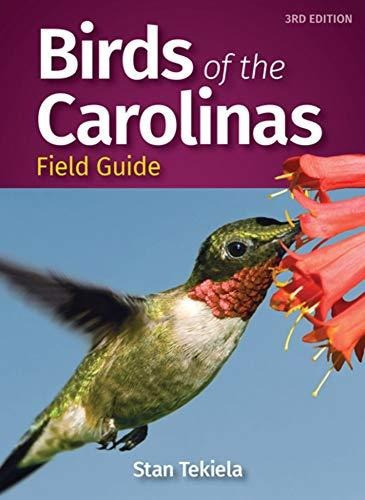Book : Birds Of The Carolinas Field Guide (bird...
Pagá en cuotas
Llega gratis el martes 21 de mayo
Solo en CABA y zonas de GBA
Comprando dentro de las próximas 6 h 38 min
Retirá gratis entre el 21 y el 24/mayo en correo y otros puntos
Ver en el mapaDisponible 15 días después de tu compra
MercadoLíder | +10mil ventas
MercadoLíder Platinum
+10mil
Ventas concretadas
Brinda buena atención


Descripción
- ANTES DE COMPRAR PREGUNTE FECHA DE ENTREGA.
- ENVIAMOS POR MERCADOENVIOS
- PUEDE RETIRAR POR AHORA SOLO POR QUILMES, MICROCENTRO ESTA CERRADO, POR ESO...
- EN CABA (CAPITAL FEDERAL) ENVIAMOS SIN CARGO ESTE PRODUCTO.
- FORMA DE PAGO : MERCADOPAGO
- HACEMOS FACTURA A.
- ELBAZARDIGITAL VENDEDOR PLATINUM
- TODOS NUESTROS PRODUCTOS EN:
https://eshops.mercadolibre.com.ar/elbazardigital
-X-X-X-
- SOMOS IMPORTADORES DIRECTOS, ESTE PRODUCTO SE COMPRA Y SE IMPORTA DESDE ESTADOS UNIDOS, ESTO IMPLICA QUE USTED ESTA COMPRANDO EL MISMO PRODUCTO QUE COMPRARÍA UN CLIENTE DE ESE PAÍS.
- ANTES DE REALIZAR UNA CONSULTA, VISUALICE TODAS LAS IMAGENES DEL PRODUCTO.
Descripción provista por la editorial :
Get the New Edition of the Carolinas’ Best-Selling Bird GuideLearn to identify birds in North Carolina and South Carolina, and make bird-watching even more enjoyable. With Stan Tekiela’s famous field guide, bird identification is simple and informative. There’s no need to look through dozens of photos of birds that don’t live in your area. This book features 146 species of North and South Carolina birds organized by color for ease of use. Do you see a yellow bird and don’t know what it is? Go to the yellow section to find out.Book Features:146 species: Only North Carolina and South Carolina birdsSimple color guide: See a yellow bird? Go to the yellow sectionCompare feature: Decide between look-alikesStan’s Notes: Naturalist tidbits and factsProfessional photos: Crisp, stunning full-page imagesThis new edition includes more species, updated photographs and range maps, revised information, and even more of Stan’s expert insights. So grab Birds of the Carolinas Field Guide for your next birding adventure-to help ensure that you positively identify the birds that you see. About the Author Naturalist, wildlife photographer and writer Stan Tekiela is the originator of the popular state-specific field guide series. Stan has authored more than 190 educational books, including field guides, quick guides, nature books, children’s books, playing cards and more, presenting many species of animals and plants. With a Bachelor of Science degree in Natural History from the University of Minnesota and as an active professional naturalist for more than 30 years, Stan studies and photographs wildlife throughout the United States and Canada. He has received various national and regional awards for his books and photographs. Also a well-known columnist and radio personality, his syndicated column appears in more than 25 newspapers, and his wildlife programs are broadcast on a number of Midwest radio stations. Stan can be followed on and Twitter. Excerpt. © Reprinted by permission. All rights reserved. Northern Cardinal Cardinalis cardinalisSize: 8-9 (20-22.5 cm) Female: buff brown bird with tinges of red on crest and wings, a black mask and large red bill Male: red bird with a black mask extending from face down to chin and throat, large red bill and crest Juvenile: same as female, but with a blackish gray bill Nest: cup; female builds; 2-3 broods per year Eggs: 3-4; bluish white with brown markings Incubation: 12-13 days; female and male incubate Fledging: 9-10 days; female and male feed young Migration: non-migrator Food: seeds, insects, fruit; comes to seed feeders Compare: The Cedar Waxwing (pg. 133) has a small dark bill. The female Northern Cardinal appears similar to juvenile Cardinal, but the juvenile has a dark bill. Look for female’s bright red bill. Stan’s Notes: A familiar backyard bird. Look for male feeding female during courtship. Male feeds young of first brood by himself while female builds a second nest. Their name comes from the Latin word cardinalis, which means “important.” Very territorial during spring, it will fight its own reflection in a window. Non-territorial in winter, they gather in small flocks of up to 20 birds. Both male and female sing and can be heard any time of year. Listen for their “whata-cheer-cheer-cheer” territorial call in spring.
-o-o-o-
Garantía del vendedor: 90 días
Preguntas y respuestas
¿Qué querés saber?
Preguntale al vendedor
Nadie hizo preguntas todavía. ¡Hacé la primera!

